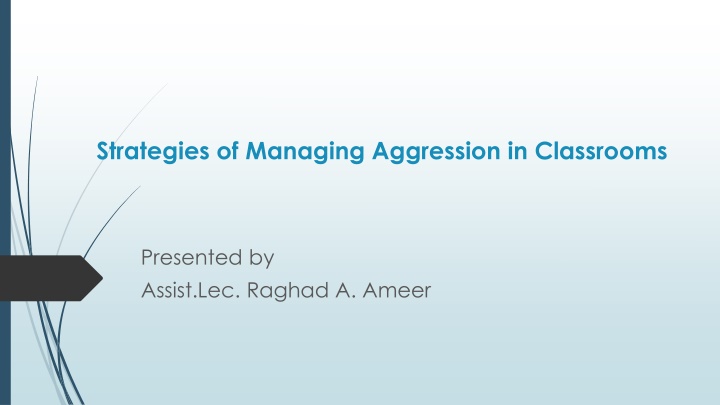
Effective Strategies for Managing Aggression in Educational Settings
Explore the definition, types, contributing factors, and impact of aggression in classrooms. Discover essential strategies to address aggression and cultivate a safer learning environment. Understand the psychological effects and consequences on university communities. Gain insights into managing physical, verbal, and relational aggression effectively to enhance academic performance and organizational reputation.
Download Presentation

Please find below an Image/Link to download the presentation.
The content on the website is provided AS IS for your information and personal use only. It may not be sold, licensed, or shared on other websites without obtaining consent from the author. If you encounter any issues during the download, it is possible that the publisher has removed the file from their server.
You are allowed to download the files provided on this website for personal or commercial use, subject to the condition that they are used lawfully. All files are the property of their respective owners.
The content on the website is provided AS IS for your information and personal use only. It may not be sold, licensed, or shared on other websites without obtaining consent from the author.
E N D
Presentation Transcript
Strategies of Managing Aggression in Classrooms Presented by Assist.Lec. Raghad A. Ameer
In this workshop, the following topics will be discussed: Definition of Aggression Types of Aggression Factors Contributing to Aggression Consequences of Aggression Strategies to Address Aggression
Aggression "Aggression" is defined as the purposeful behaviour which is intended to cause physical or psychological harm to others. "Aggression" is defined as behavior that is intended to harm another individual who does not wish to be harmed. Aggression is considered to be a type of behaviour aiming to injure or irritate other person, or to damage a thing or issue in such a way as to inhibit its functioning or use.
Types of Aggression Physical behaviors such as pushing, hitting, kicking, and other forms of physical violence. While less common than verbal aggression or bullying, physical aggression can have serious consequences and may lead to injuries or legal repercussions. Verbal Aggression: Verbal behaviors such as yelling, name-calling, intimidation, and verbal threats. Verbal aggression can occur between students, between faculty members, or between students and faculty. Relational Aggression (Indirect aggression): is seen as the act of harming another without a direct face to face encounter, for instance talking behind someone's back. Aggression: Physical aggression includes Aggression: This includes
Contributing factors It is estimated that 246 million students around the world experience at least one type of aggression, such as physical, psychological, and sexual violence (UNESCO,2017). Stress and pressure: Academic stress, financial pressures, and personal issues can exacerbate aggressive behavior among students and faculty. Social dynamics: Family factors such as parental marital conflict and childhood adverse experiences, and cultural norms can influence the prevalence of aggression. Mental health: Underlying mental health conditions, such as depression, anxiety, or personality disorders, may contribute to aggressive behavior. Substance abuse: Alcohol and drug abuse can lower inhibitions and increase the likelihood of aggressive incidents. Other factors: weather conduction, race , gender, age, Student-Teacher Relationship, .. .
Impact of Aggression on University Communities Psychological effects: Aggressive behavior can lead to feelings of fear, anxiety, and insecurity among students, faculty, and staff. Academic performance: Aggression may disrupt learning environments, leading to decreased academic performance and retention rates. Organizational reputation: High-profile incidents of aggression can tarnish the reputation of universities and deter prospective students and faculty.
Strategies for Prevention and Management Promoting a culture of respect: Implementing policies and initiatives that foster respect, tolerance and can help create a positive campus environment. Providing support services: Offering counseling, mental health resources, and conflict resolution programs can assist individuals in managing stress and addressing underlying issues. Educating the community: Raising awareness about the consequences of aggression and providing training on conflict resolution and bystander intervention can empower individuals to intervene effectively. Implementing disciplinary measures: aggressive behavior sends a message that such conduct will not be tolerated within the university community. One effective strategy for preventing aggressive behaviour is teaching conflict resolution and anger management skills to students. By providing them with tools to handle conflicts peacefully, you empower them to resolve issues without resorting to aggression. Enhancing security measures: Increasing the presence of campus security personnel and implementing surveillance systems can help deter and respond to incidents of aggression. Enforcing clear consequences for
Implementing De-escalation Techniques During Confrontations Remain calm: Displaying anger or frustration may only increase the student s aggression. Instead, speak softly and maintain a neutral tone. Active listening: Show genuine interest in what the student has to say, allowing them to express their feelings without interruption. This demonstrates respect and can help diffuse tension. Empathy and understanding: Try to put yourself in the student s shoes and understand their perspective. Validating their emotions can help reduce their agitation. Non-threatening body language: Stand at an appropriate distance from the student, keeping your body relaxed and open. Avoid crossing your arms or displaying any aggressive gestures. Harshly disciplining an aggressive student might fuel his anger and make him more determined to continue the aggressive behavior. After the aggressive student cools down, talk with him privately.
Rates of Aggression in Arabic Countries 65.80% 46.60% 45.90% 43.20% 41.60% IRAQ-AL-SADR CITY LEBANON JORDON OMAN UAE
